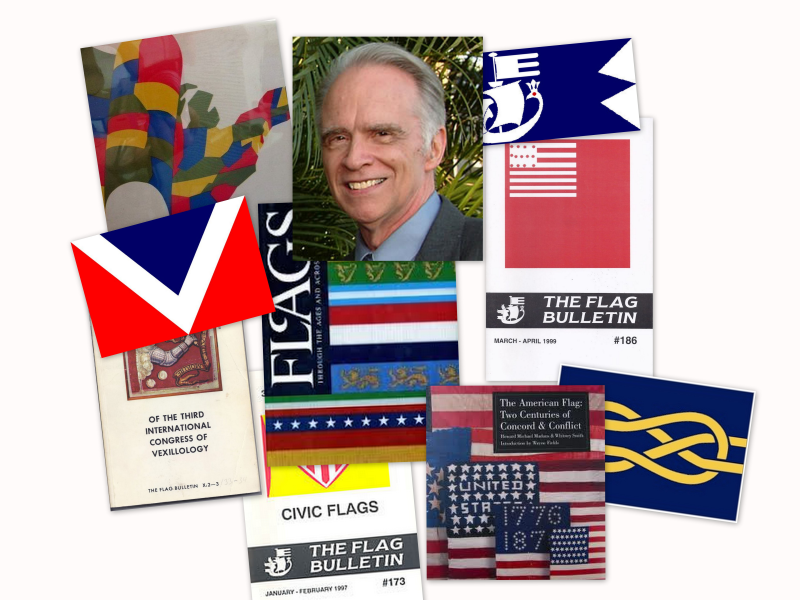Vexillology?

Dr. Whitney Smith and a few of his publications with the flags of the Flag Research Center, the North American Vexillological Association and the International Federation of Vexillological Associations.
Short history of this discipline
Flag-post.com announces itself as presenting “Flag Facts-Flag News & More.” There is a word for such an undertaking, “vexillology.” The Merriam Webster Dictionary defines the term simply as “the study of flags” while a more elaborate definition stretches the meaning to “the scientific study of the history, symbolism, and usage of flags.”
The story of vexillology reaches back more than fifty years to 1957 when a teenager from Boston became a summer intern at the United Nations headquarters in New York. Seventeen year old Whitney Smith was a young man fascinated by flags. With all the flags flying around the U.N. building, he was certain that it was the place to study flags, but to his dismay the U.N. did not have a special department to categorize and record the flags of its member nations. The closest thing he could locate was the map department since illustrations of flags sometimes appear in the margins of maps.
In the Cartography or map section he encountered prominent map makers who called themselves cartographers. “If you who study maps are called cartographers,” Whitney asked, “what are we called who study flags?” They likely smiled and showed obvious condescension for the study of flags when they answered that there was no such word, and no such study.
Whitney found dictionaries of the ancient Latin and Greek languages, and using them created the words to describe the study of flags and the scholars who study them. A Latin word for flag, he found was “vexillum,” and the ancient Greek suffix describing the study of a subject was “ology.” He joined the two to create “vexillology,” “vexillological,” and “vexillologist. “ These U.N. gurus of maps were no doubt amused and assumed that the young man’s coined word would be forgotten when Smith returned to Boston and found new and more exciting pursuits.
If so, they underestimated Whitney and his passion for the study of flags. He not only created a word but the scholarly discipline which the word describes. Whitney earned a bachelor’s degree from Harvard University, and then went on to earn a master’s degree and a doctorate from Boston University. There was not a PhD in Vexillology available, so he received his in Political Science; however, his subject was clearly flags.
Whitney established the Flag Research Center and produced The Flag Bulletin: the International Journal of Vexillology, a scholarly publication about flags. He joined with other vexillologists to found the North American Vexillological Association in 1967 as well as the International Federation of Vexillological Associations founded in the same year. A prolific author, he has published books about flags that number in the dozens and his flag articles are almost countless. Britannica, Americana, World Book, Compton’s—over the years Whitney wrote the flag articles for almost every prominent encyclopedia.
He directed the Flag Research Center and published the Flag Bulletin for fifty years and has only recently scaled back his activities. The North American Vexillological Association has grown to well over four hundred members in the United States and Canada, and will hold its 47th Annual Meeting in Salt Lake City, Utah this coming October. The International Federation of Vexillological Associations is now comprised of fifty-five regional, national, and multinational associations and institutions located in the Americas, Europe, Africa and Asia.
When arguing details of flag research, vexillologists around the world do not always agree, but they do always agree that Whitney Smith has been instrumental in creating vexillology.
At Colonial Flag, we are dedicated to flags. Please visit our website for a great selection of flags, flagpoles, accessories and tutorial videos.